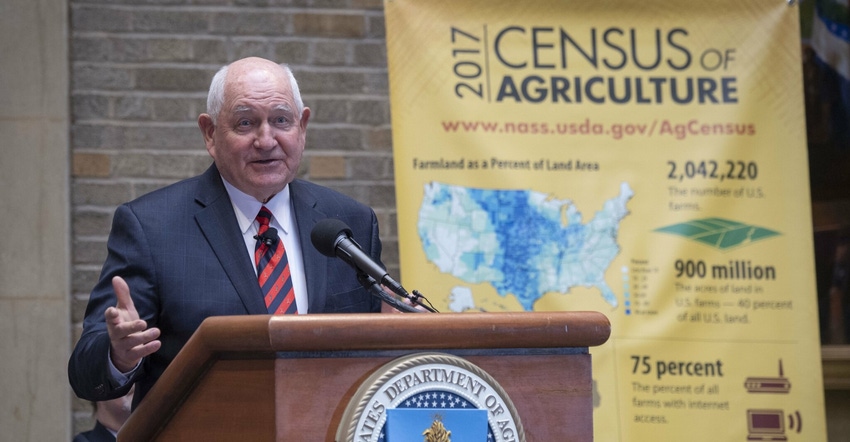'Census of Ag' gives insight into farm demographics
Latest data collected every five years show aging average farm population and fewer midsized farms yet still growing segment of young farmers.

The U.S. Department of Agriculture announced the results of the 2017 "Census of Agriculture", which reveals an aging average farm population and slightly lower total number of farms. The results of the 2017 "Census of Agriculture" span some 6.4 million new points of information about America’s farms and ranches and those who operate them, including new data about on-farm decision-making, down to the county level.
Information collected by USDA’s National Agricultural Statistics Service (NASS) directly from farmers and ranchers shows that both farm numbers and land in farms have seen ongoing small percentage declines since the last census in 2012. At the same time, there continue to be more of the largest and smallest operations and fewer midsized farms.
The census found that there are 2.04 million farms and ranches (down 3.2% from 2012), with an average size of 441 acres (up 1.6%), on 900 million acres (down 1.6%). A total of 96% of farms and ranches are family owned.
The 273,000 smallest farms (one to nine acres) make up 0.1% of all farmland, while the 85,127 largest farms (2,000 acres or more) make up 58% of farmland. Just 105,453 farms produced 75% of all sales in 2017, down from 119,908 in 2012. Of the 2.04 million farms and ranches, the 76,865 making $1 million or more in 2017 represent just more than two-thirds of the $389 billion in total value of production, while the 1.56 million operations making under $50,000 represent just 2.9%.
The average age of all producers is 57.5, up 1.2 years from 2012. Producers also tend to be experienced; they had been on their current farm an average of 21.3 years.
However, there is a growing segment of young farmers. There are 321,261 young producers age 35 or younger on 240,141 farms. Farms with young producers making decisions tend to be larger than average in both acres and sales. More than any other age group, young producers make decisions regarding livestock, though the difference is slight. One in four producers is a beginning farmer with 10 or fewer years of experience and an average age of 46.3. Farms with new or beginning producers making decisions tend to be smaller than average in both acres and value of production.
For the 2017 census, NASS changed the demographic questions to better represent the roles of all persons involved in on-farm decision-making. As a result, in 2017, the number of producers is up by nearly 7% to 3.4 million because more farms reported multiple producers. Most of these newly identified producers are female. While the number of male producers fell 1.7% to 2.17 million from 2012 to 2017, the number of female producers increased by nearly 27% to 1.23 million. This change underscores the effectiveness of the questionnaire changes, NASS said.
Thirty-six percent of all producers are female, and 56% of all farms have at least one female decision-maker. Farms with female producers making decisions tend to be smaller than average in both acres and value of production. Female producers are most heavily engaged in the day-to-day decisions, along with record-keeping and financial management.
The number of producers who have served in the military totals 370,619, or 11% of all producers, and they are older than the average, at 67.9.
In 2017, 130,056 farms sold directly to consumers, with sales of $2.8 billion, while 28,958 operations sold to retail outlets, institutions and food hubs, with sales valued at $9 billion.
National Farmers Union president Roger Johnson said the most striking figure from the census was that more than 56% of all American farms and ranches had negative net cash farm income in 2017.
“Significant financial stress is weighing on American agriculture,” Johnson said. “The economic decline over the last five years is forcing many farmers out of business, continuing the trends of farm consolidation and rural economic degeneration we’ve seen for many years.”
Farms with Internet access rose from 69.6% in 2012 to 75.4% in 2017.
A total of 133,176 farms and ranches use renewable energy-producing systems, more than double the level of 57,299 in 2012.
“The census shows new data that can be compared to previous censuses for insights into agricultural trends and changes down to the county level,” NASS Administrator Hubert Hamer said. “While the current picture shows a consistent trend in the structure of U.S. agriculture, there are some ups and downs since the last census as well as first-time data on topics such as military status and on-farm decision-making. To make it easier to delve into the data, we are pleased to make the results available in many online formats, including a new data query interface, as well as traditional data tables.”
Secretary of Agriculture Sonny Perdue added, “We can all use the census to tell the tremendous story of U.S. agriculture and how it is changing. As a data-driven organization, we are eager to dig in to this wealth of information to advance our goals of supporting farmers and ranchers, facilitating rural prosperity and strengthening stewardship of private lands efficiently, effectively and with integrity.”
About the Author(s)
You May Also Like





